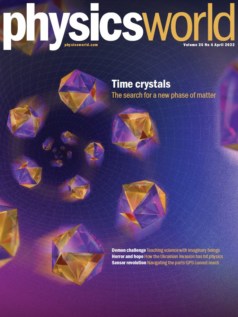Google’s Pedram Roushan explores the quest for elusive “time crystals”, Lia Li outlines her ambitions as tech start-up founder and Robert P Crease looks at how demons can help teach science

If there’s one thing you can be sure of here at Physics World, it’s that any coverage of “time crystals” gets lapped up by readers.
With that in mind, the cover feature of the new April 2022 issue of Physics World magazine, is sure to intrigue you.
Written by Pedram Roushan from Google’s AI quantum team in California, the article describes this elusive form of matter and how it could be simulated on the company’s Sycamore quantum processor.
You can also read the article on the website from Monday 4 April 2022.
Remember that if you’re a member of the Institute of Physics, you can read the whole of Physics World magazine every month via our digital apps for iOS, Android and Web browsers. Let us know what you think about the issue on Twitter, Facebook or by e-mailing us at pwld@ioppublishing.org.
For the record, here’s a rundown of what else is in the issue.
• AI keeps fusion plasma in check – A reinforcement-learning algorithm has managed to manipulate and control a high-temperature plasma in a tokamak. Edwin Cartlidge reports
• Physics community condemns Russia – The Russian invasion of Ukraine has been met with an unprecedented response from the international scientific community, which will have far-reaching repercussions for science. Michael Banks investigates
• Crisis in Ukraine – Russia’s invasion of Ukraine is a test for those who want science and politics kept apart
• The problem with renewables – Peter Edwards, Peter Dobson and Gari Owen say that net-zero targets can only be met if renewable energy can be stored cost-effectively
• Supercool thinker – James McKenzie looks back at the remarkable life of the late Sir Martin Wood, who was a pioneer in the commercialization of physics research
• The laser physicist unlocking navigation technology – Lia Li is an award-winning start-up founder bringing optomechanical sensors to consumers. She talks to Laura Hiscott about a childhood spent in university labs, the switch from academia to business and using LIGO-style technology to help us navigate where global navigation satellite systems can’t

Free to read: the March 2022 edition of Physics World is now out
• Time crystals: the search for a new phase of matter – Pedram Roushan, from Google’s Quantum AI team in California, describes this elusive form of matter – and how it could be simulated on the company’s Sycamore quantum processor
• Letting demons do the teaching – Smart and rebellious, demons have a long and rich history in both science and culture. Robert P Crease explains how these little creatures have inspired him to create a university course that should appeal to humanities and science students alike
• Racing to save the planet – Diandra Leslie-Pelecky reviews Racing Green: How Motorsport Science Can Change the World by Kit Chapman
• A giant of nanoscience – Jess Wade reviews Carbon Queen: the Remarkable Life of Nanoscience Pioneer Mildred Dresselhaus by Maia Weinstock
• Using physics to patent inventions – Having originally done a PhD in quantum computing, Katherine Brown is now a patent attorney at international law firm CMS. She describes what a job in patent law entails and explains why a scientific background is an asset in this area
• Ask me anything – Martin Weides is head of the quantum-circuits group at the University of Glasgow, UK, and also consultant technical director to the UK-based firm Oxford Instruments Nanoscience
• Walking on the Moon – John Hardwick tries to work out how much energy you’d need to move around on the lunar surface
Enjoy the issue – and do let us know what you think by e-mailing physics.world@ioppublishing.org.



